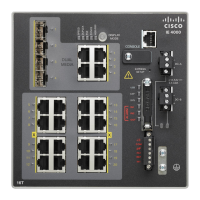539
Configuring SNMP
How to Configure SNMP
4. snmp-server group groupname {v1 |
v2c | v3 {auth | noauth | priv}} [read
readview] [write writeview] [notify
notifyview] [access access-list]
Configures an SNMP group.
5. snmp-server host host-addr
[informs | traps] [version {1 | 2c | 3
{auth | noauth | priv}}]
community-string [notification-type]
Specifies the recipient of an SNMP trap operation.
host-addr—Specifies the name or Internet address of the host (the
targeted recipient).
(Optional) informs—Specifies SNMP informs to be sent to the host.
(Optional) traps (the default)—Specifies SNMP traps to be sent to the
host.
(Optional) Specifies the SNMP version (1, 2c, or 3). SNMPv1 does
not support informs.
(Optional) Version 3—Selects authentication level auth, noauth, or
priv.
Note: The priv keyword is available only when the cryptographic
software image is installed.
community-string—When version 1
or version 2c is specified, enters
the password-like community string sent with the notification
operation. When version 3 is specified, enter the SNMPv3
username.
Note: The @ symbol is used for delimiting the context information. Avoid
using the @ symbol as part of the SNMP community string when
configuring this command.
(Optional) notification-type—Specifies a notification type. Use the
keywords listed in Table 54 on page 532. If no type is specified, all
notifications are sent.
6. snmp-server enable traps
notification-types
Enables the switch to send traps or informs and specifies the type of
notifications to be sent. For a list of notification types, see Table 54 on
page 532, or enter snmp-server enable traps ?
To enable multiple types of traps, you must enter a separate
snmp-server enable traps command for each trap type.
Note: When you configure a trap by using the notification type
port-security, configure the port security trap first, and then configure
the port security trap rate:
snmp-server enable traps port-security
snmp-server enable traps port-security trap-rate rate
7. snmp-server trap-source interface-id (Optional) Specifies the source interface, which provides the IP address
for the trap message. This command also sets the source IP address for
informs.
Command Purpose

